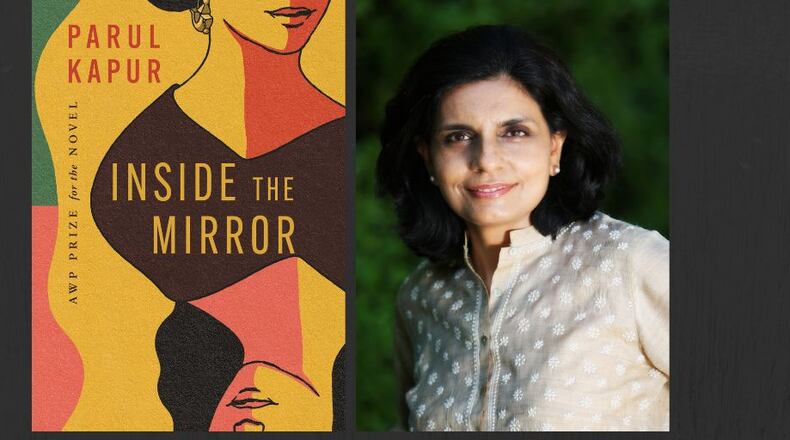Atlanta author Parul Kapur’s “Inside the Mirror” is an enveloping work of historical fiction centered on artistic twin sisters coming of age in 1950s Bombay (present-day Mumbai) that delivers an evocative study on the modern art movement in India.
The story opens with twins and expands the concept of dual nature into a compelling exploration of the self vs society. As the characters push for their own advancements, India’s independence from British rule and the Partition of India force changes many citizens find difficult to embrace.
Dualism, defined by Merriam-Webster’s dictionary as “a theory that considers reality to consist of two irreducible elements or modes,” is a primary theme in this character-driven tale focused on the plight of women during this turbulent historical time. The story opens with sisters who appear identical but aren’t. Their clothes are the easiest way to tell 18-year-old Jaya and Kamlesh Malhotra apart. Jaya favors saris, “like a grown-up woman,” while Kamlesh still dresses in skirts and blouses from their childhood.
Those differences are only the starting point as Kapur dives into her protagonists. Jaya and Kamlesh are the granddaughters of esteemed freedom fighter Bebeji, a powerful woman during a time when women were frequently subservient. Bebeji fought with Mahatma Gandhi to overthrow the British and was imprisoned. She raised the twins’ father, Harbans, to value women. He prioritizes his daughters’ education, often to their mother Vidya’s dismay.
As Jaya advances through medical school and Kamlesh studies to become a teacher, it becomes apparent these young women have passions that reside elsewhere — Jaya is an artist and Kamlesh is a dancer. While their artistic pursuits matter more to the twins than to their parents, Harbans supports these hobbies so long as his daughters excel in school.
But Vidya’s priority for her girls is to secure good marriages. Bebeji agrees that family forms the foundation for life and promotes it as the natural next step for her granddaughters. As the struggle between the women’s interests and societal expectations intensify, Kapur’s exploration of art and dance forms the heart of this novel.
The fluidity with which Kapur morphs Jaya’s medical training into artistic inspiration is breathtaking. At the novel’s opening, Jaya feels constrained by the confines of her predetermined future. She expresses her frustrations through drawing still lifes of dead flowers, effectively “trapping herself in a garden of vases” to symbolize her stagnancy.
Her medical-school cadaver captures Jaya’s fascination as she ruminates on how the 35-year-old unblemished man could have lived and died. Seeking a connection, she holds his leathery hand and notes how “strange and repulsive the hard, slick crust of his skin” feels against hers. Before long she’s sketching hands, then faces. Eventually her passion becomes movement, and she starts painting a series of Kamlesh dancing in various poses.
Kamlesh also experiences an internal shift with her dancing. Kapur draws a mesmerizing correlation between the reclamation of Indian identity following colonial rule and Kamlesh’s embodiment of the Hindu goddesses in her movements.
The prose shimmers as Kapur brings these two elements together in Jaya’s description of painting “parts of her sister’s physiognomy into sculpture, curving thick stone lips in a contented smile, dangling stiff pendants from her long ears, though the figure herself was fractured.” The influences of cubism and modern art shape Jaya’s work as she studies with an avant-garde teacher.
Jaya discovers it’s tricky to paint one’s twin and not have her work perceived as self-referential. Once her art begins exploring the female form and is deemed provocative, 1950s social mores clamp down on her creativity and she faces backlash.
Controversy touches both sisters as Harbans determines Kamlesh’s dancing is inappropriate and stops her lessons. Kamlesh is devastated to lose access to her passion and descends into a crippling depression. The narrative assumes a melancholic tone as the twins endure emotional estrangement from their own selves, each other and their families for asserting choice over their lives.
This is a dense story packed with rich characters and brimming with timely references to India’s changing landscape. A forbidden Bengali boy adds to the social pressures the Malhotra sisters must navigate on the harrowing road to self-fulfillment. Through it all, Kapur infuses her protagonists with agency even as she remains honest in her depiction of the personal cost Jaya and Kamlesh pay.
Using duality to highlight similarities shared by differing factions, the twins’ individual struggles for independence sits beautifully against India’s emergence as a free nation. Kapur reaches beyond the Malhotra family’s privilege to depict the harsh realities of poverty many citizens faced.
Bebeji discovers an impoverished village and sets out to improve their access to water, education and medicine. The twins become involved with the village children and are exposed to devastating realities their family has previously shielded them from. These experiences influence their artistic pursuits.
Parul Kapur states in the acknowledgments that her grandmother’s memories contributed significantly to “Inside the Mirror” and formed the foundation for the Malhotra family, including their name. The story itself is an homage to dualism as Kapur’s admiration for those who came before her unfolds in sweeping layers of vivid descriptions, cloistered emotions and characters who linger in the mind long after the tale’s conclusion.
FICTION
“Inside the Mirror”
by Parul Kapur
University of Nebraska Press
358 pages, $26.95
AUTHOR EVENT
Parul Kapur. In Conversation with Jessica Handler. 7 p.m., Tuesday, March 5. Free with registration. Decatur Library, 215 Sycamore St., Decatur. 404-370-3070, www.georgiacenterforthebook.org/events
About the Author
Keep Reading
The Latest
Featured


